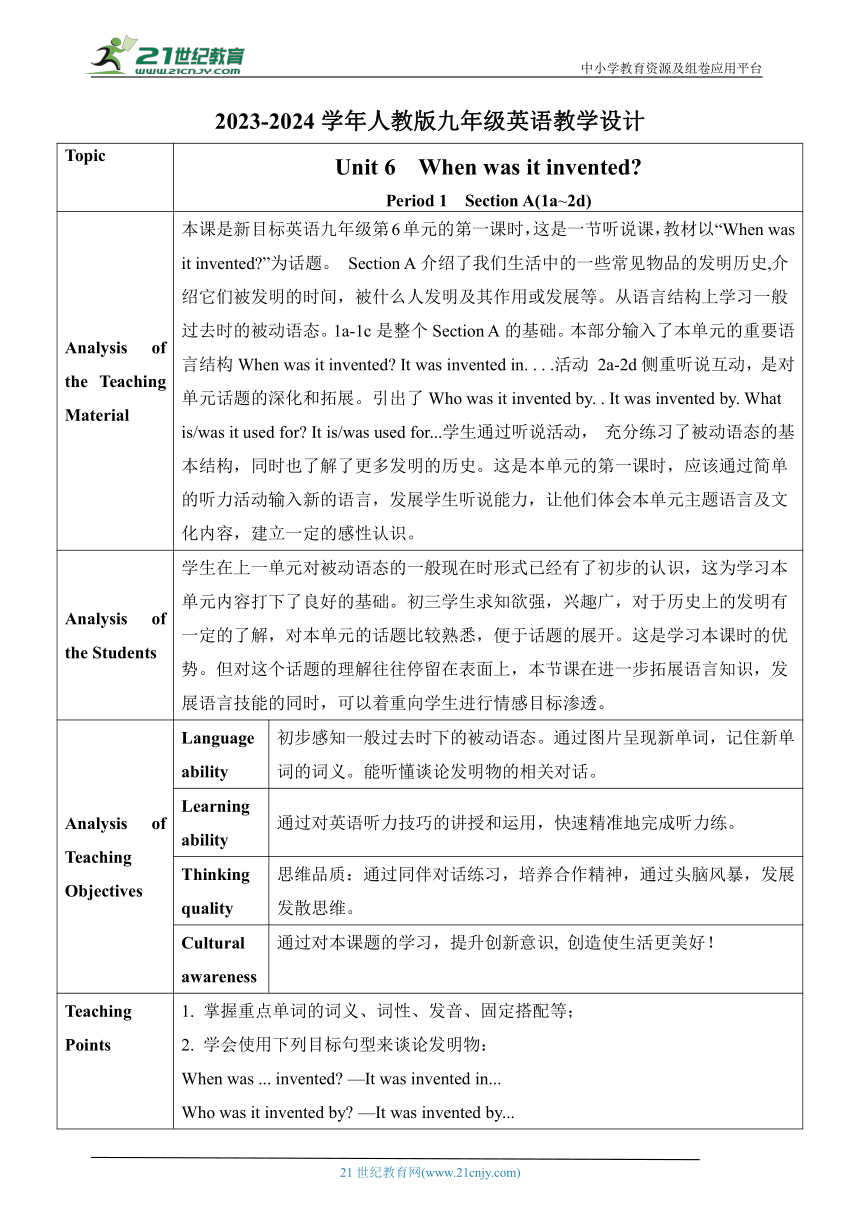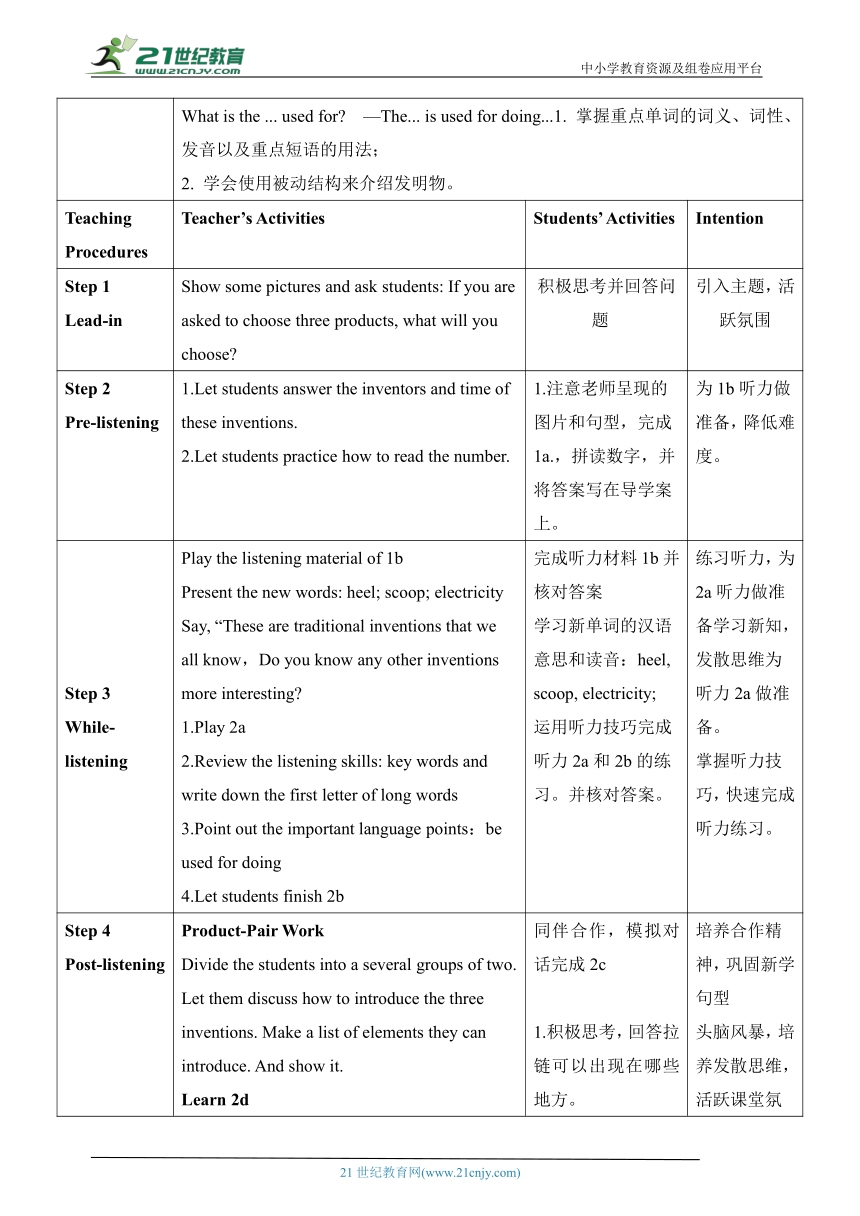【核心素养目标】Unit 6 Section A(1a~2d)表格式 教学设计 人教版九年级英语全册Unit 6 When was it invented
文档属性
| 名称 | 【核心素养目标】Unit 6 Section A(1a~2d)表格式 教学设计 人教版九年级英语全册Unit 6 When was it invented |

|
|
| 格式 | doc | ||
| 文件大小 | 195.3KB | ||
| 资源类型 | 试卷 | ||
| 版本资源 | 人教新目标(Go for it)版 | ||
| 科目 | 英语 | ||
| 更新时间 | 2023-11-17 23:11:35 | ||
图片预览


文档简介
中小学教育资源及组卷应用平台
2023-2024学年人教版九年级英语教学设计
Topic Unit 6 When was it invented Period 1 Section A(1a~2d)
Analysis of the Teaching Material 本课是新目标英语九年级第6单元的第一课时,这是一节听说课,教材以“When was it invented ”为话题。 Section A介绍了我们生活中的一些常见物品的发明历史,介绍它们被发明的时间,被什么人发明及其作用或发展等。从语言结构上学习一般过去时的被动语态。1a-1c是整个Section A的基础。本部分输入了本单元的重要语言结构When was it invented It was invented in. . . .活动 2a-2d侧重听说互动,是对单元话题的深化和拓展。引出了Who was it invented by. . It was invented by. What is/was it used for It is/was used for...学生通过听说活动,
充分练习了被动语态的基本结构,同时也了解了更多发明的历史。这是本单元的第一课时,应该通过简单的听力活动输入新的语言,发展学生听说能力,让他们体会本单元主题语言及文化内容,建立一定的感性认识。
Analysis of the Students 学生在上一单元对被动语态的一般现在时形式已经有了初步的认识,这为学习本单元内容打下了良好的基础。初三学生求知欲强,兴趣广,对于历史上的发明有一定的了解,对本单元的话题比较熟悉,便于话题的展开。这是学习本课时的优势。但对这个话题的理解往往停留在表面上,本节课在进一步拓展语言知识,发展语言技能的同时,可以着重向学生进行情感目标渗透。
Analysis of Teaching Objectives Language ability 初步感知一般过去时下的被动语态。通过图片呈现新单词,记住新单词的词义。能听懂谈论发明物的相关对话。
Learningability 通过对英语听力技巧的讲授和运用,快速精准地完成听力练。
Thinking quality 思维品质:通过同伴对话练习,培养合作精神,通过头脑风暴,发展发散思维。
Cultural awareness 通过对本课题的学习,提升创新意识, 创造使生活更美好!
Teaching Points 1. 掌握重点单词的词义、词性、发音、固定搭配等;2. 学会使用下列目标句型来谈论发明物:When was ... invented —It was invented in...Who was it invented by —It was invented by...What is the ... used for —The... is used for doing...1. 掌握重点单词的词义、词性、发音以及重点短语的用法;2. 学会使用被动结构来介绍发明物。
Teaching Procedures Teacher’s Activities Students’ Activities Intention
Step 1Lead-in Show some pictures and ask students: If you are asked to choose three products, what will you choose 积极思考并回答问题 引入主题,活跃氛围
Step 2Pre-listening 1.Let students answer the inventors and time of these inventions. 2.Let students practice how to read the number. 1.注意老师呈现的图片和句型,完成1a.,拼读数字,并将答案写在导学案上。 为1b听力做准备,降低难度。
Step 3While-listening Play the listening material of 1bPresent the new words: heel; scoop; electricitySay, “These are traditional inventions that we all know,Do you know any other inventions more interesting 1.Play 2a 2.Review the listening skills: key words and write down the first letter of long words3.Point out the important language points:be used for doing4.Let students finish 2b 完成听力材料1b并核对答案学习新单词的汉语意思和读音:heel, scoop, electricity;运用听力技巧完成听力2a和2b的练习。并核对答案。 练习听力,为2a听力做准备学习新知,发散思维为听力2a做准备。掌握听力技巧,快速完成听力练习。
Step 4Post-listening Product-Pair WorkDivide the students into a several groups of two. Let them discuss how to introduce the three inventions. Make a list of elements they can introduce. And show it.Learn 2dand make a mind map: where can we see it 2.ask 5 questions about 2d.3.Translate 2d and point out new language points. 同伴合作,模拟对话完成2c1.积极思考,回答拉链可以出现在哪些地方。2.完成导学案,阅读2d回答问题。3.翻译2d 培养合作精神,巩固新学句型头脑风暴,培养发散思维,活跃课堂氛围。语篇学习新单词。锻炼翻译能力
Step 5Language Points Explanation 1.be used for doing sth. = be used to do sth. 被用来做某事 (表用途、目的) e.g. This computer is used to control all the machines. 这台电脑是用来控制所有机器的。2. With pleasure. 我很乐意。 My pleasure.不客气;不用谢。是回答对方感谢的客气话。pleasant adj. 高兴的; 满意的pleased adj. 令人高兴的; 令人满意的3.such +a/an + adj.+单数可数名词=so +adj.+a/an+单数可数名词: 如此……的一个……e.g. She is such a lovely girl. =She is so lovely a girl.辨析: such/ sosuch一般用作定语,修饰名词,放在所修饰词的前面。so用来修饰形容词或副词。 4.think about 考虑,想起 e.g. He is thinking about travelling in the summer holidays. 他正在考虑暑假旅游的事。 think of 考虑, 记忆, 记起think sth. over 仔细想, 审慎思考, 作进一步考虑think sth. out 想通, 想出, 熟思daily adj. 日常的 n.日报 adv.每天 5.助动词do放在动词seem前面主要用来加强语气,“的确,确实”。 在谓语动词前添加助动词do表示强调的用法常见于肯定句和祈使句中。 6.have a point 有道理mention v. 提到; 说到 mention sth. /sb. 提到某事/某人 将知识点做好笔记 将本课重点汇总系统的进行讲解和分析,结合典例,帮助学生形成语言体系。
Step6Exercises 一、用所给词的适当形式填空1. The blender is used for____ (make)a banana milk shake. 2. The car_________ (invent)in 1885. 3. They____ (use)animals to do this kind of work in the past. 4. Tom takes no__________ (please)in his work. 5. Electricity is becoming more and more important in our______ (day)lives.二、 句型转换1. The TV was invented around 1927. (对画线部分提问)__________ __________ the TV__________ 2. Paper was invented by Cai Lun. (对画线部分提问)__________ __________ paper__________ __________ 3. Sunglasses are used for keeping out the sunshine. (对画线部分提问)__________ __________ sunglasses__________ for 4.They built a bridge over the river last year. (改为被动语态)A bridge__________ __________ over the river last year. 5. The book was written by Mo Yan. (改为否定句)The book__________ __________ by Mo Yan. 完成课堂练习。 让学生在课上练习消化知识点,及时操练重点知识点和目标语言,让教师把握学情。
Step 7Summary Make a summary about this lesson. Lists the important phrases and sentences.phrases1. 靠电力运行 run on electricity2. 被用来做…… be used for ... 3. 想出 think of4. 乐意效劳! With pleasure! 5. 如此伟大的一项发明such a great invention6. 在我们的日常生活 in our daily lives 7. 有道理 have a point8. 不同发明的先驱者 the pioneers of different inventionsSentences1.---When was it invented ---It was invented in1876.2.--- Who was it invented by --- It was invented by Bell.3.---What is it used for ---It is used for talking with people. 回顾和总结本节课所学的单词、短语、句子。大声朗读所呈现的短语和句型 总结本课所学内容,强调重点单词、短语、句子.巩固所学知识
Step 8Homework Present homework:1.Review the new words and expressions. (B层)2. Make a brief introduction about an invention that you know!(50-100字)。 (A层) 完成课后作业 作业分A,B两层布置,因材施教
Blackboard Design Unit 6 When was it invented Period Ⅰ Section A(1a~2d)New words:heel; scoop; electricity Key sentences:When was ... invented —It was invented in... Who was it invented by —It was invented by... What is the ... used for —The... is used for doing...
Teaching Reflection: 亮点
1.本节课首先通过多媒体展示图片引出本单元主题词汇,让学生在情景中理解学习新词汇,同时提供听说训练。2.通过要求学生谈论发明时间的先后顺序引出一般过去时被动语态的结构。然后通过听说活动让学生不断感知目标语言,逐渐学会使用一般过去时被动语态的结构谈论发明。3.本节课设置了真实而自然的教学情景,让学生在听说训练中感知并运用被动语态。
有待改进 1.学生较容易出错的地方,一个是易漏掉be动词,再一个是易写错动词的过去分词形式。教师在课堂上强调到位。2.本节课活动确保学生足够的练习量,使其能够充分感知被动语态。3.上课关注度和关注面不够,有待加强。老师在课堂上应尽可能多地提供给学生表达的机会。
21世纪教育网 www.21cnjy.com 精品试卷·第 2 页 (共 2 页)
HYPERLINK "http://www.21cnjy.com/" 21世纪教育网(www.21cnjy.com)
2023-2024学年人教版九年级英语教学设计
Topic Unit 6 When was it invented Period 1 Section A(1a~2d)
Analysis of the Teaching Material 本课是新目标英语九年级第6单元的第一课时,这是一节听说课,教材以“When was it invented ”为话题。 Section A介绍了我们生活中的一些常见物品的发明历史,介绍它们被发明的时间,被什么人发明及其作用或发展等。从语言结构上学习一般过去时的被动语态。1a-1c是整个Section A的基础。本部分输入了本单元的重要语言结构When was it invented It was invented in. . . .活动 2a-2d侧重听说互动,是对单元话题的深化和拓展。引出了Who was it invented by. . It was invented by. What is/was it used for It is/was used for...学生通过听说活动,
充分练习了被动语态的基本结构,同时也了解了更多发明的历史。这是本单元的第一课时,应该通过简单的听力活动输入新的语言,发展学生听说能力,让他们体会本单元主题语言及文化内容,建立一定的感性认识。
Analysis of the Students 学生在上一单元对被动语态的一般现在时形式已经有了初步的认识,这为学习本单元内容打下了良好的基础。初三学生求知欲强,兴趣广,对于历史上的发明有一定的了解,对本单元的话题比较熟悉,便于话题的展开。这是学习本课时的优势。但对这个话题的理解往往停留在表面上,本节课在进一步拓展语言知识,发展语言技能的同时,可以着重向学生进行情感目标渗透。
Analysis of Teaching Objectives Language ability 初步感知一般过去时下的被动语态。通过图片呈现新单词,记住新单词的词义。能听懂谈论发明物的相关对话。
Learningability 通过对英语听力技巧的讲授和运用,快速精准地完成听力练。
Thinking quality 思维品质:通过同伴对话练习,培养合作精神,通过头脑风暴,发展发散思维。
Cultural awareness 通过对本课题的学习,提升创新意识, 创造使生活更美好!
Teaching Points 1. 掌握重点单词的词义、词性、发音、固定搭配等;2. 学会使用下列目标句型来谈论发明物:When was ... invented —It was invented in...Who was it invented by —It was invented by...What is the ... used for —The... is used for doing...1. 掌握重点单词的词义、词性、发音以及重点短语的用法;2. 学会使用被动结构来介绍发明物。
Teaching Procedures Teacher’s Activities Students’ Activities Intention
Step 1Lead-in Show some pictures and ask students: If you are asked to choose three products, what will you choose 积极思考并回答问题 引入主题,活跃氛围
Step 2Pre-listening 1.Let students answer the inventors and time of these inventions. 2.Let students practice how to read the number. 1.注意老师呈现的图片和句型,完成1a.,拼读数字,并将答案写在导学案上。 为1b听力做准备,降低难度。
Step 3While-listening Play the listening material of 1bPresent the new words: heel; scoop; electricitySay, “These are traditional inventions that we all know,Do you know any other inventions more interesting 1.Play 2a 2.Review the listening skills: key words and write down the first letter of long words3.Point out the important language points:be used for doing4.Let students finish 2b 完成听力材料1b并核对答案学习新单词的汉语意思和读音:heel, scoop, electricity;运用听力技巧完成听力2a和2b的练习。并核对答案。 练习听力,为2a听力做准备学习新知,发散思维为听力2a做准备。掌握听力技巧,快速完成听力练习。
Step 4Post-listening Product-Pair WorkDivide the students into a several groups of two. Let them discuss how to introduce the three inventions. Make a list of elements they can introduce. And show it.Learn 2dand make a mind map: where can we see it 2.ask 5 questions about 2d.3.Translate 2d and point out new language points. 同伴合作,模拟对话完成2c1.积极思考,回答拉链可以出现在哪些地方。2.完成导学案,阅读2d回答问题。3.翻译2d 培养合作精神,巩固新学句型头脑风暴,培养发散思维,活跃课堂氛围。语篇学习新单词。锻炼翻译能力
Step 5Language Points Explanation 1.be used for doing sth. = be used to do sth. 被用来做某事 (表用途、目的) e.g. This computer is used to control all the machines. 这台电脑是用来控制所有机器的。2. With pleasure. 我很乐意。 My pleasure.不客气;不用谢。是回答对方感谢的客气话。pleasant adj. 高兴的; 满意的pleased adj. 令人高兴的; 令人满意的3.such +a/an + adj.+单数可数名词=so +adj.+a/an+单数可数名词: 如此……的一个……e.g. She is such a lovely girl. =She is so lovely a girl.辨析: such/ sosuch一般用作定语,修饰名词,放在所修饰词的前面。so用来修饰形容词或副词。 4.think about 考虑,想起 e.g. He is thinking about travelling in the summer holidays. 他正在考虑暑假旅游的事。 think of 考虑, 记忆, 记起think sth. over 仔细想, 审慎思考, 作进一步考虑think sth. out 想通, 想出, 熟思daily adj. 日常的 n.日报 adv.每天 5.助动词do放在动词seem前面主要用来加强语气,“的确,确实”。 在谓语动词前添加助动词do表示强调的用法常见于肯定句和祈使句中。 6.have a point 有道理mention v. 提到; 说到 mention sth. /sb. 提到某事/某人 将知识点做好笔记 将本课重点汇总系统的进行讲解和分析,结合典例,帮助学生形成语言体系。
Step6Exercises 一、用所给词的适当形式填空1. The blender is used for____ (make)a banana milk shake. 2. The car_________ (invent)in 1885. 3. They____ (use)animals to do this kind of work in the past. 4. Tom takes no__________ (please)in his work. 5. Electricity is becoming more and more important in our______ (day)lives.二、 句型转换1. The TV was invented around 1927. (对画线部分提问)__________ __________ the TV__________ 2. Paper was invented by Cai Lun. (对画线部分提问)__________ __________ paper__________ __________ 3. Sunglasses are used for keeping out the sunshine. (对画线部分提问)__________ __________ sunglasses__________ for 4.They built a bridge over the river last year. (改为被动语态)A bridge__________ __________ over the river last year. 5. The book was written by Mo Yan. (改为否定句)The book__________ __________ by Mo Yan. 完成课堂练习。 让学生在课上练习消化知识点,及时操练重点知识点和目标语言,让教师把握学情。
Step 7Summary Make a summary about this lesson. Lists the important phrases and sentences.phrases1. 靠电力运行 run on electricity2. 被用来做…… be used for ... 3. 想出 think of4. 乐意效劳! With pleasure! 5. 如此伟大的一项发明such a great invention6. 在我们的日常生活 in our daily lives 7. 有道理 have a point8. 不同发明的先驱者 the pioneers of different inventionsSentences1.---When was it invented ---It was invented in1876.2.--- Who was it invented by --- It was invented by Bell.3.---What is it used for ---It is used for talking with people. 回顾和总结本节课所学的单词、短语、句子。大声朗读所呈现的短语和句型 总结本课所学内容,强调重点单词、短语、句子.巩固所学知识
Step 8Homework Present homework:1.Review the new words and expressions. (B层)2. Make a brief introduction about an invention that you know!(50-100字)。 (A层) 完成课后作业 作业分A,B两层布置,因材施教
Blackboard Design Unit 6 When was it invented Period Ⅰ Section A(1a~2d)New words:heel; scoop; electricity Key sentences:When was ... invented —It was invented in... Who was it invented by —It was invented by... What is the ... used for —The... is used for doing...
Teaching Reflection: 亮点
1.本节课首先通过多媒体展示图片引出本单元主题词汇,让学生在情景中理解学习新词汇,同时提供听说训练。2.通过要求学生谈论发明时间的先后顺序引出一般过去时被动语态的结构。然后通过听说活动让学生不断感知目标语言,逐渐学会使用一般过去时被动语态的结构谈论发明。3.本节课设置了真实而自然的教学情景,让学生在听说训练中感知并运用被动语态。
有待改进 1.学生较容易出错的地方,一个是易漏掉be动词,再一个是易写错动词的过去分词形式。教师在课堂上强调到位。2.本节课活动确保学生足够的练习量,使其能够充分感知被动语态。3.上课关注度和关注面不够,有待加强。老师在课堂上应尽可能多地提供给学生表达的机会。
21世纪教育网 www.21cnjy.com 精品试卷·第 2 页 (共 2 页)
HYPERLINK "http://www.21cnjy.com/" 21世纪教育网(www.21cnjy.com)
同课章节目录
- Unit 1 How can we become good learners.
- Section A
- Section B
- Unit 2 I think that mooncakes are delicious!
- Section A
- Section B
- Unit 3 Could you please tell me where the restroom
- Section A
- Section B
- Unit 4 I used to be afraid of the dark.
- Section A
- Section B
- Unit 5 What are the shirts made of?
- Section A
- Section B
- Review of Units 1-5
- Unit 6 When was it invented?
- Section A
- Section B
- Unit 7 Teenagers should be allowed to choose their
- Section A
- Section B
- Unit 8 It must belong to Carla.
- Section A
- Section B
- Unit 9 I like music that I can dance to.
- Section A
- Section B
- Unit 10 You're supposed to shake hands.
- Section A
- Section B
- Review of Units 6-10
- Unit 11 Sad movies make me cry.
- Section A
- Section B
- Unit 12 Life is full of the unexpected
- Section A
- Section B
- Unit 13 We're trying to save the earth!
- Section A
- Section B
- Unit 14 I remember meeting all of you in Grade 7.
- Section A
- Section B
- Review of Units 11-14
